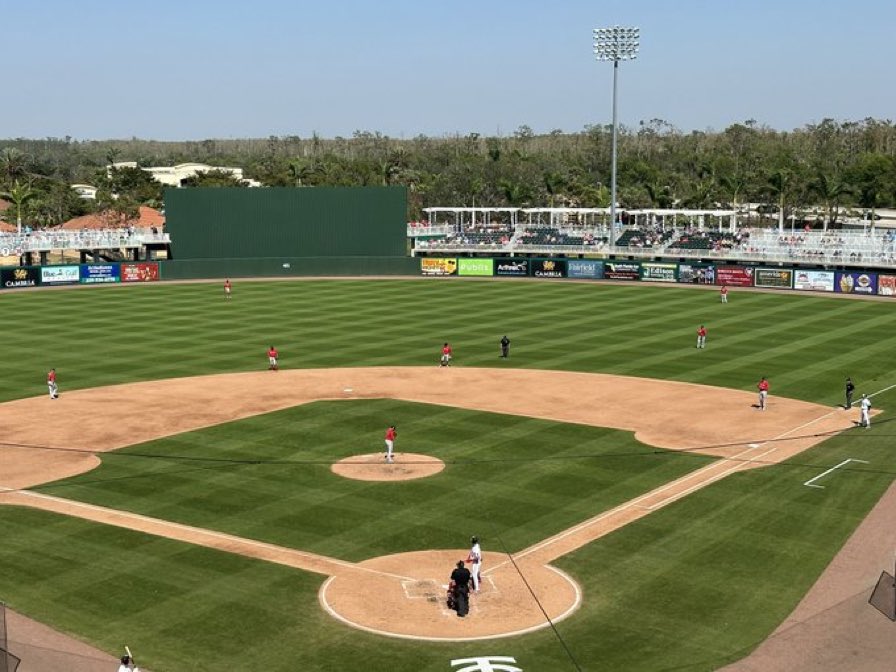
Photo via Aaron Gleeman of The Athletic
Major League Baseball has several new rules going into effect for the 2023 season. The new rules have been tested in spring training (except for the shortened time to decide on replay reviews), discussed, debated, and in the case of when the clock starts between batters, slightly tweaked. There may be another new twist during the upcoming season, as teams try to find a way to shift within the rules.
The rule on infielder positioning states that there must be two infielders on each side of second base, with their feet touching the infield dirt when the pitch is thrown. Fair enough. The rule does not mandate where outfielders must be stationed, and for some teams, that has already created an opportunity for innovation.
During spring training, several teams brought an outfielder to play a deep second base position against left-handed pull hitters, leaving two outfielders and left field wide open. A case in point, as documented by Jayson Stark in The Athletic, was March 3 when the Red Sox were playing the Twins. It’s no surprise that the Red Sox would be one of the teams experimenting, after all, they’re guided by the hand of Chaim Bloom, the general manger who found creative ways to keep the under-funded Rays in contention for years. The hitter against whom the experiment took place was none other than Joey Gallo, the quintessential pull hitter (when he makes contact). Other teams tried the two-man outfield during spring training, Will we see it during the regular season?
Here’s Bloom from the article:
“I don’t think we’ve seen everything we’re going to see,” he said. “But I also think you have to give MLB credit. The rules have been written and clarified in such a way as to take away a lot of the obvious loopholes that aren’t in the spirit of the rules. And that’s important, because this wasn’t done to bring more innovation or trick plays. It was done to get to a version of our game that feels better.”
It sounds like Bloom, and likely other general managers, are concocting ways to position fielders in compliance with the rules, but in a way that creates a statistical advantage given hitters’ tendencies. In order for creative shifts, or any shifts, to be effective, they have to be employed in the right situations. If the two-outfielder shift leaves left field open, which hitters are least likely to beat the shift by hitting a ball to left field?
Stark provides some context in his article. These hitters are least likely to hit fly balls to left field:
| Player | Opposite Field Fly Ball Percentage |
| Ozzie Albies | 12.3 |
| Anthony Santander | 13.7 |
| Jorge Polanco | 15.2 |
| Jonah Heim | 15.2 |
| Joey Gallo | 16.2 |
| Francisco Mejia | 16.9 |
| Daulton Varsho | 17.1 |
Teams that go with a two-outfielder shift will be taking a gamble, because the stakes will be higher than in the past. If hitters beat the traditional shift, the result was most often a single through a vacated hole. With left field wide open, the result of beating the shift can be a double, triple, or even an inside-the-park home run.
Given the increased risk, managers will likely use the two-outfielder shift sparingly. In a sense, it’s like defensive strategy in football. Sure, a team can blitz the linebackers, but if the play backfires, the offense can achieve a significant gain with so much open ground in the defensive backfield. Contrast that to a safety blitz, where only one defender leaves his position. A backfire there likely results in a smaller gain for the offense. The moral of the story is that shifting can still occur, but will be a bigger gamble and most likely used far less often that we have become used to seeing.
Just how often might we see an outfield where, as Keith Hernandez would say, “you could drive a tank division through there.” Stark documents a conversation he had with two unnamed baseball executives on expected frequency of creative shifting, such as a two-man outfield.
“Under a dozen, comfortably,” an exec said, then waved over another member of his front office to pose the same question.
“If you’re asking what’s the over/under line, I’d say a dozen,” that exec said.
“I thought it would probably be closer to a half-dozen,” the first exec replied.
It may be fun to see a two-man outfield. Perhaps we will when Daniel Vogelbach strides to the plate. The situation will have to be right. It’s doubtful teams will use the shift when there are runners on base, the risk would be too high. However, imagine seeing Vogelbach run around the bases, with fans (if at Citi Field) standing and yelling “stop!” while others yell “go!”. All the while, Vogelbach is chugging, seemingly in slow motion.
Baseball is supposed to be fun. Now that would be fun.
















